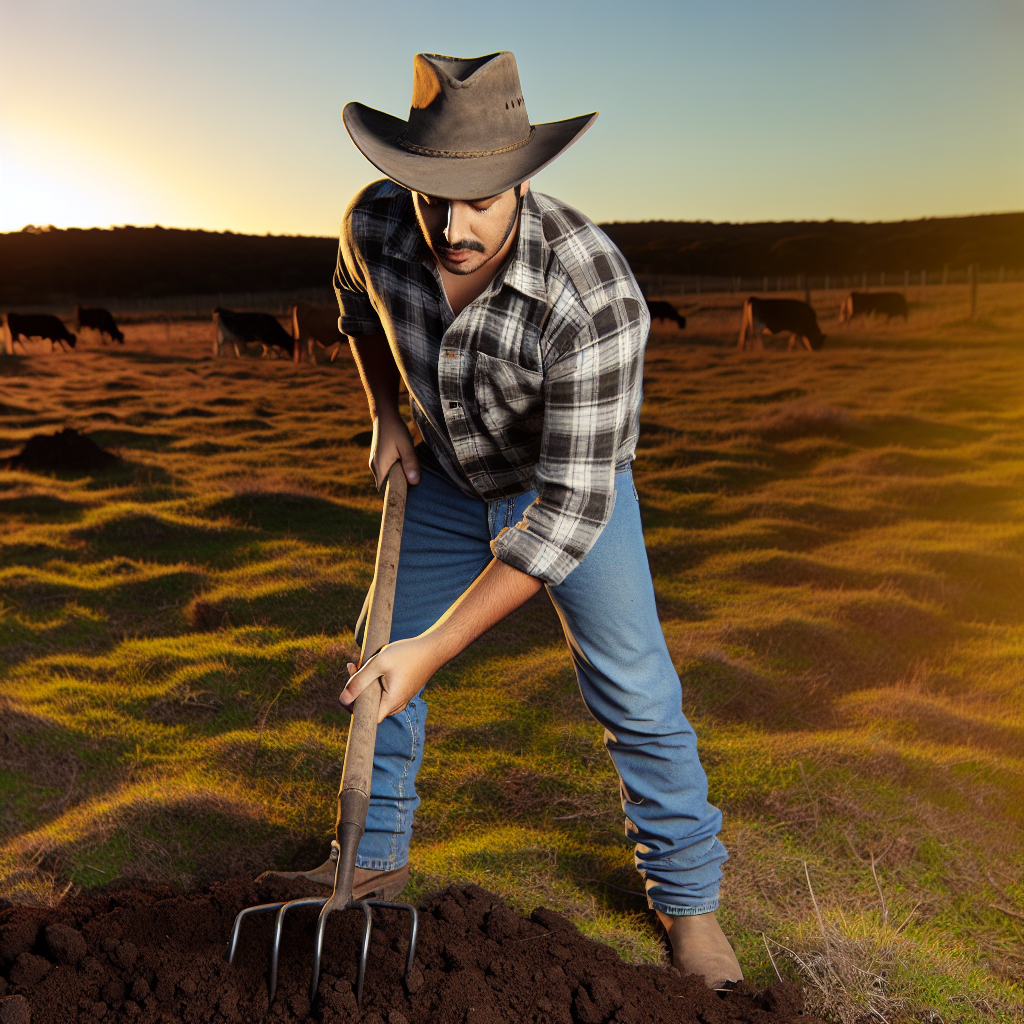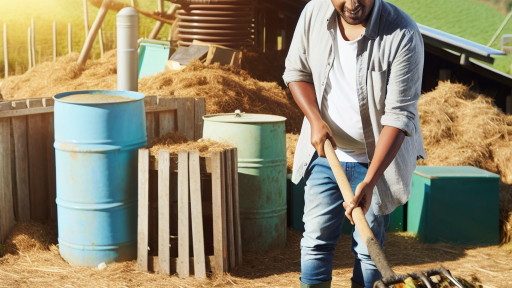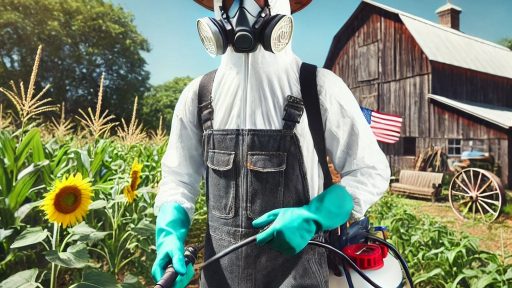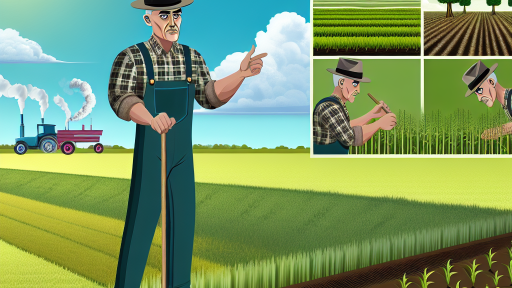Introduction to Sustainable Grazing
Definitions of Sustainable Grazing
Sustainable grazing involves using grasslands for livestock management in an ecologically responsible way.
This approach maintains the health of the pasture while allowing livestock to thrive.
It focuses on balancing livestock needs and soil health.
Importance of Sustainable Grazing
Sustainable grazing practices play a crucial role in soil care.
Healthy soil supports productive agricultural systems.
Additionally, it helps improve water retention and reduce runoff.
Soil health enhances biodiversity, leading to more resilient ecosystems.
Furthermore, sustainable grazing can sequester carbon, combating climate change.
Key Benefits
- Improves soil structure and fertility.
- Reduces erosion and enhances water management.
- Promotes diverse plant communities.
- Increases the resilience of grazing systems.
By adopting sustainable grazing methods, farmers can achieve long-term ecological and economic benefits.
Benefits of Sustainable Grazing for Soil Health
Enhancing Soil Structure
Sustainable grazing practices improve soil structure significantly.
This improvement enhances water infiltration and retention.
As a result, plants receive the moisture they need to thrive.
Increasing Soil Organic Matter
Regularly rotated grazing increases soil organic matter.
Organic matter plays a crucial role in nutrient availability.
It also enhances soil’s capacity to store carbon.
Transform Your Agribusiness
Unlock your farm's potential with expert advice tailored to your needs. Get actionable steps that drive real results.
Get StartedPromoting Biodiversity
Sustainable grazing encourages diverse plant and animal species.
This biodiversity contributes to a balanced ecosystem.
Moreover, it strengthens resilience against pests and diseases.
Reducing Soil Erosion
Controlled grazing minimizes soil erosion risks.
It preserves the topsoil essential for crop production.
Healthy root systems further anchor the soil in place.
Improving Nutrient Cycling
Sustainable grazing optimizes nutrient cycling within the soil.
This process enhances the availability of essential minerals.
Consequently, crops grow more robust and productive.
Contributing to Carbon Sequestration
Proper grazing management plays a vital role in carbon sequestration.
This practice traps carbon that would otherwise enter the atmosphere.
As a result, it combats climate change effectively.
Principles of Soil Care in Grazing Management
Integrating Soil Health into Grazing Practices
Effective grazing management begins with understanding soil health.
Healthy soil supports plant growth and contributes to ecosystem functionality.
Farmers must regularly assess soil conditions to inform their practices.
Monitoring soil organic matter is particularly important for soil vitality.
Additionally, incorporating cover crops enhances nutrient cycling.
Diverse Grazing Strategies
Diverse grazing strategies improve soil health through varied plant interactions.
Rotational grazing promotes even forage consumption and soil regeneration.
This method prevents overgrazing in any single area.
Moreover, managing grazing intensity positively influences soil composition.
Minimizing Soil Disturbance
Minimized soil disturbance is critical in sustainable grazing.
Implementing controlled grazing limits soil compaction.
This way, root systems can thrive and improve water infiltration.
Showcase Your Farming Business
Publish your professional farming services profile on our blog for a one-time fee of $200 and reach a dedicated audience of farmers and agribusiness owners.
Publish Your ProfileFurthermore, reducing tractor traffic preserves soil structure and integrity.
Utilizing Organic Fertilizers
Organic fertilizers enhance soil fertility while reducing chemical inputs.
Manure from grazing animals serves as an excellent organic amendment.
It enriches soil with essential nutrients and microbial life.
Regular application of compost also fosters a healthy soil ecosystem.
Encouraging Biodiversity
Biodiversity in grazing systems nurtures better soil health.
Diverse plant species support various soil organisms.
This interconnectedness boosts nutrient availability and resilience.
Additionally, polyculture systems contribute to enhanced soil structure.
Delve into the Subject: Sustainable Farm Planning Techniques For Climate Resilience
Rotational Grazing: Enhancing Pasture and Soil Health
Understanding Rotational Grazing
Rotational grazing involves moving livestock between pastures regularly.
This strategy promotes healthy grass growth and improves soil health.
Livestock graze on one pasture while allowing others to recover.
This method mimics natural grazing patterns seen in wild herds.
Benefits of Rotational Grazing
One significant benefit is improved pasture quality.
Healthy grasses can grow more vigorously with proper management.
These grasses provide better nutrition for livestock.
Moreover, rotational grazing enhances soil structure and fertility.
Microbial activity increases, leading to better nutrient cycling.
This practice also helps reduce soil erosion over time.
Implementing Rotational Grazing
Farmers should first assess their land and resources.
Next, they should design a grazing plan that suits their operation.
Creating smaller paddocks is crucial for effective rotation.
Schedule regular intervals for livestock rotation to give pastures rest.
Additionally, monitor pasture and livestock health consistently.
Challenges of Rotational Grazing
Incorporating rotational grazing may pose some initial challenges.
For instance, it requires careful planning and management.
Farmers may also need to invest in fencing materials.
However, the long-term benefits significantly outweigh these obstacles.
Case Studies of Successful Practices
Many farms have successfully implemented rotational grazing.
Green Meadows Farm saw increased pasture yield after a year.
Sunny Acres Ranch improved their soil structure and water retention.
Both farms exemplify how effective this method can be.
Sustainable Practices for Future Farming
In summary, rotational grazing fosters sustainable land management.
It enhances both pasture and soil health over time.
Farmers can achieve productivity while caring for the environment.
Gain More Insights: Conservation Tillage Benefits For Sustainable Farming
Integrating Cover Crops in Grazing Systems
Benefits of Cover Crops
Cover crops provide multiple benefits to grazing systems.
Firstly, they improve soil health significantly.
Secondly, cover crops enhance nutrient cycling in the soil.
Showcase Your Farming Business
Publish your professional farming services profile on our blog for a one-time fee of $200 and reach a dedicated audience of farmers and agribusiness owners.
Publish Your ProfileMoreover, they help in preventing soil erosion.
Consequently, they promote biodiversity in the agricultural ecosystem.
Types of Cover Crops
Choosing the right cover crop is crucial for a successful integration.
Leguminous cover crops, such as clover, fix nitrogen in the soil.
Grass cover crops, like rye and oats, prevent weed growth.
Mustard and radish can improve soil structure effectively.
Implementing Cover Crops in Grazing Systems
To integrate cover crops successfully, plan ahead.
Start by selecting appropriate cover crops for your region.
Consider the timing of planting and grazing carefully.
Additionally, monitor soil conditions regularly to adjust practices.
Grazing Management Practices
Grazing management is essential for maintaining cover crops.
Limit grazing during critical growth periods of cover crops.
Use rotational grazing to minimize soil compaction.
Furthermore, adjust stock density to avoid overgrazing.
Potential Challenges
Integrating cover crops may present some challenges.
One risk is potential competition with cash crops.
Additionally, managing diverse species can be complex.
However, these challenges are often manageable with proper planning.
Long-term Benefits
In the long run, integrating cover crops boosts soil health.
Improved soil health leads to increased productivity.
Furthermore, it enhances resilience against climate variability.
Ultimately, this practice supports sustainable farming initiatives.
Learn More: Carbon Sequestration Through Regenerative Farming
Impact of Livestock Type on Soil Quality and Health
Understanding Livestock Varieties
Different types of livestock contribute varying impacts on soil quality.
Cattle, sheep, goats, and pigs each have unique grazing habits.
Understanding these distinctions is vital for sustainable practices.
Effects of Cattle on Soil
Cattle tend to compact the soil due to their size and weight.
This compaction can reduce water infiltration and root growth.
However, cattle also help recycle nutrients through their manure.
Properly managed grazing can enhance soil structure over time.
Rotational grazing allows for recovery periods for pastures.
The Role of Sheep in Soil Health
Sheep typically graze closer to the ground compared to cattle.
This grazing behavior can manage weed populations effectively.
Sheep droppings are generally smaller and can benefit soil microbial activity.
Additionally, their grazing promotes nutrient cycling in pastures.
Goats and Their Unique Grazing Habits
Goats prefer browsing shrubs over grazing grass.
This behavior can control invasive plant species.
They also disturb the soil less, which can help preserve soil structure.
Proper goat management can lead to biodiversity in plant life.
Pigs and Soil Disturbance
Pigs are known for rooting in the soil, which can cause significant disturbance.
Showcase Your Farming Business
Publish your professional farming services profile on our blog for a one-time fee of $200 and reach a dedicated audience of farmers and agribusiness owners.
Publish Your ProfileThis behavior can lead to soil aeration and increased nutrient availability.
However, excessive rooting can degrade soil health.
Controlled grazing with pigs can balance these pros and cons.
Integrating Diverse Livestock Systems
Combining different livestock types can promote soil health.
This strategy leverages the strengths of each animal.
For instance, using cattle and sheep together can optimize pasture use.
This combination enhances nutrient cycling and reduces weed pressure.
Sustainable livestock management also includes systematic rotation.
Long-Term Benefits of Proper Management
Healthy soils are crucial for resilient agricultural systems.
They support diverse ecosystems and enhance crop yields.
Managing livestock effectively ensures ongoing soil fertility.
It also leads to improved water quality and prevents erosion.
See Related Content: Reducing Chemical Inputs To Protect Soil Health

Monitoring Soil Health Indicators in Grazing Areas
Importance of Soil Health
Soyl health significantly affects agricultural productivity.
Healthy soil enhances plant growth and resilience.
Additionally, it supports diverse ecosystems in grazing areas.
Key Soil Health Indicators
Monitoring soil health requires specific indicators.
Common indicators include soil organic matter and compaction.
Other crucial indicators are pH levels and microbial activity.
Soil Organic Matter
Soil organic matter improves soil structure and fertility.
It increases water retention and nutrient availability.
Soil Compaction
Compacted soil restricts root growth and water infiltration.
Regular checks can help identify compaction issues.
pH Levels
Soil pH affects nutrient availability to plants.
Monitoring pH ensures proper nutrient management.
Microbial Activity
Healthy microbial activity indicates a thriving soil ecosystem.
Microbes play a vital role in decomposing organic matter.
Methods for Monitoring Soil Health
Various methods exist for monitoring soil health indicators.
Soil sampling and analysis provide essential data.
Visual observations also help assess soil condition.
Soil Testing
Regular soil testing quantifies soil properties.
Laboratory tests can measure organic matter and pH levels.
Visual Assessment
Visual inspections can reveal signs of erosion or compaction.
Identifying plant health can indicate soil quality.
Practical Applications of Soil Monitoring
Implementing soil monitoring guides grazing management.
It allows for informed decisions on pasture rotation.
Additionally, it supports targeted soil amendments.
Case Studies: Successful Sustainable Grazing Practices
Cattle Ranching in Colorado
A ranch called Green Pastures implements rotational grazing effectively.
This method helps maintain soil health while maximizing pasture growth.
As a result, the ranch sees improved biodiversity in its fields.
Showcase Your Farming Business
Publish your professional farming services profile on our blog for a one-time fee of $200 and reach a dedicated audience of farmers and agribusiness owners.
Publish Your ProfileAdditionally, it enhances the nutritional content of the soil.
Sheep Farming in New Zealand
Blue Sky Farm utilizes cover cropping alongside grazing.
This practice prevents soil erosion and promotes nutrient cycling.
Consequently, the farm experiences increased crop yields.
Clients appreciate the commitment to environmental stewardship.
Dairy Farming in Wisconsin
Sunny Fields Dairy integrates agroforestry with its grazing system.
This innovative approach provides shade for animals during hot months.
Moreover, it helps reduce water runoff and soil degradation.
Farmers note an uptick in milk production and animal health.
Lessons from the Field
Implementing sustainable practices promotes both livestock well-being and soil care.
Farmers must adapt to local environmental conditions for success.
By sharing knowledge, producers can inspire each other to improve.
Ultimately, sustainable grazing practices foster long-term agricultural resilience.
Challenges and Solutions in Adopting Sustainable Grazing
Identifying Common Challenges
Farmers often struggle with the transition to sustainable grazing methods.
Financial constraints limit their ability to invest in new practices.
Additionally, there is a lack of knowledge regarding sustainable techniques.
Weather variability can also pose challenges for effective grazing management.
Furthermore, land degradation from improper practices creates additional hurdles.
Addressing Financial Constraints
Accessing grants can help farmers offset initial costs.
Programs from organizations like the Soil Conservation Society provide funding opportunities.
Furthermore, cooperative purchasing can reduce expenses for equipment and resources.
Farmers can also explore diversified income sources, such as eco-tourism.
Expanding Knowledge and Training
Educational workshops on sustainable grazing can build essential skills.
Collaboration with local agricultural extension services offers valuable training.
Furthermore, online resources and webinars create flexible learning opportunities.
Participating in local farming groups fosters knowledge sharing among peers.
Adapting to Climate Variability
Farmers can implement rotational grazing to promote pasture recovery.
Monitoring weather patterns helps inform grazing decisions.
Utilizing drought-resistant forage can also mitigate climate impacts.
By diversifying livestock types, farms become more resilient to changing conditions.
Combating Land Degradation
Restoration practices, such as cover cropping, improve soil health.
Integrating agroforestry systems enhances biodiversity within grazing lands.
Regular soil assessments can guide better management of land resources.
Lastly, employing fencing can prevent overgrazing in sensitive areas.
The Future of Grazing and Soil Care
Emphasizing Sustainable Practices
Sustainable grazing practices are crucial for soil care.
They help improve soil health and increase fertility.
Effective management minimizes negative impacts on ecosystems.
Adapting to Climate Change
Climate change poses challenges for agriculture.
Sustainable grazing can mitigate some of these effects.
For instance, it promotes carbon sequestration in soil.
Showcase Your Farming Business
Publish your professional farming services profile on our blog for a one-time fee of $200 and reach a dedicated audience of farmers and agribusiness owners.
Publish Your ProfileFarmers must adapt grazing strategies to shifting weather patterns.
Research and Innovation
Investing in research can advance sustainable grazing.
New technologies enhance monitoring and management techniques.
For example, precision grazing methods optimize land use.
These innovations support farmers in making informed decisions.
Collaborative Efforts
Collaboration among stakeholders is vital for success.
Farmers, researchers, and policymakers should work together.
This includes sharing knowledge and resources effectively.
Community initiatives can strengthen sustainable practices.
Long-Term Vision
A long-term vision aligns sustainable grazing with economic goals.
Farmers can benefit financially from improved soil health.
This approach supports resilient agricultural systems.
Ultimately, it fosters environmental sustainability for future generations.




